As lockdown restrictions ease in the UK, with hospitality businesses such as restaurants, pubs, bars, and cafes now able to reopen for indoor drinking and dining, small dinner parties are also permitted. As of Monday 17th May, groups of six or two households are able to meet indoors, providing an ideal opportunity to show off those new cooking skills picked up over various states of lockdown. These are our favourite dinner party recipes.
The best dinner party recipes
White Asparagus with Ricotta, Pine Nuts & Jasmine Honey
A tell-tale sign of spring’s arrival, asparagus is in season. Using white asparagus, admired on the continent, chef Tony Fleming steamed white asparagus dish is joined by homemade jasmine honey, pine nut praline with a whisper of garlic, and fresh ricotta. The dish has an exceptional balance of both flavour and texture, worth every second of the preparation time. You can also save some time by making the jasmine honey in advance.
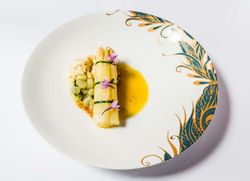
White Asparagus with Ricotta, Pine Nuts & Jasmine Honey
Ingredients
- 20 White asparagus
For the pine nut praline
- 125 grams Pine nuts
- 1 kilogram Garlic Minced
- 25 grams Extra virgin olive oil
- 12 grams Extra virgin rapeseed oil
- 1 kilogram Salt
For the jasmine honey
- 300 grams Runny honey
- 100 grams Water
- 2 Jasmine teabags Split open
For the jasmine and honey dressing
- 2 Lemons Zest and juice (90g lemon juice required)
- 60 grams Jasmine honey
- 2 grams Salt
- 120 grams Virgin rapeseed oil
For the fresh ricotta
- 1 litre Whole milk
- 125 grams Buttermilk
- 50 grams Whipping cream
- 3 grams Salt
- Citric acid a small pinch
Instructions
To prepare the white asparagus stems
- Peel the white asparagus evenly, removing as little as possible if thin but going around it twice to remove all the stringy bits when thick.
- Steam the asparagus for 10-12 minutes until just tender, check with the tip of a sharp knife, it should slip into the bottom of the asparagus with little resistance.
- Refresh immediately in iced water.
- When cold, remove and place on a tray in fridge to dry.
- To portion, cut asparagus to 12cm from the tip allowing 5 spears per person.
- Cut each spear into halves when small and quarters when larger while keeping them whole so they appear uncut.
- For the white asparagus slices: using the trim from the portions, cut 2mm slices up until the asparagus becomes too woody
To prepare the pine nut praline
- Lightly dress the pine nuts in the rapeseed oil and toast on a flat tray in a preheated oven at 170C until golden throughout. Leave to cool.
- Roughly chop half of the pine nuts.
- Blend the remainder with the olive oil, garlic and salt, on a low speed in a blender, to a coarse puree.
- Mix the chopped nuts into this.
To prepare the jasmine honey
- Bring honey and water to the boil and add tea. Allow to cool.
To prepare the jasmine honey dressing
- Blend the jasmine honey, salt, zest and juice together.
- Gradually add the oil in a thin stream as if making a mayonnaise
To prepare the fresh ricotta
- Place the milk, buttermilk, cream and salt in a pan and gently bring to 82 degrees Celsius.
- Add citric acid and stir to dissolve being careful not to agitate too much.
- The milk should start to separate leaving a pillows of curd surround by a greenish whey.
- At this point leave to cool slightly before straining over muslin/cheese cloth and hang until firm.
- When curds are dry, refrigerate.
To serve
- Place a spoon of the pine nut praline on to the plate.
- Dress the slices of asparagus with a little of the dressing and season with sea salt, place this over pine nuts.
- Place a spoon of the ricotta next to the asparagus slices, drizzle over a little jasmine honey and a pinch of sea salt.
- Place a bundle (5 pieces) of the cut asparagus stems next on to the ricotta, season with sea salt.
- Pour a generous amount of the honey dressing next to the asparagus and serve.
Multi-coloured ravioli with butter & sage
Chef Danilo Cortellini’s multi-coloured pasta is a particularly impressive dinner party dish, filled with fresh ricotta, sage, and Grana Padano cheese. You can also make the dish vegetarian by substituting the Grana Padano for a vegetarian-friendly alternative.
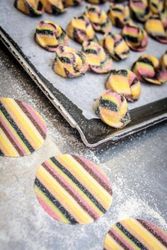
Multi-coloured Ravioli with Butter & Sage
Ingredients
- 400 g Fresh ricotta
- 50 g Unsalted butter
- Sage 1 small bunch
- 60 g Grana Padano cheese grated
- Salt and pepper, to taste
For the Yellow Pasta
- 2 Fresh Italian yellow eggs (they have a deeper colour)
- 200 g 00 flour
For the Green Pasta
- Parsley 1 small bunch
- 2 Fresh eggs
- 200 g 00 flour
For the Pink Pasta
- 2 Fresh eggs
- 20 g Cooked beetroot
- 1 tsp Beetroot juice
- 240 g 00 flour
Instructions
To Make the Yellow Pasta
- Knead the egg with the flour until it makes a smooth and elastic dough. You only reach the right consistency if the pasta has been worked hard enough to allow the gluten molecules to break down; the dough’s elasticity is very important for the final result.
- Wrap in cling film and let it rest for 30 minutes.
To Make the Green Pasta
- Blanch the parsley leaves in salted boiling water then cool in iced water to retain their colour.
- Blend the cooked parsley with eggs and knead the egg mixture with the flour until smooth and elastic. It should have the same consistency as the yellow pasta.
- Wrap in cling film and let it rest for 30 minutes.
To Make the Pink Pasta
- Blend the beetroot well with the beetroot juice and the egg.
- Knead the pink egg mixture with the 00 flour until elastic and smooth. If a pasta is too dry, add a bit of egg. If the pasta is too wet, add a little flour.
- Wrap in cling film and let it rest for 30 minutes.
- Roll out 3 sheets of the same thickness through the pasta machine for each colour. The thickness of the sheet will correspond to the thickness of the coloured stripe.
- Once all the pasta doughs have been rolled out, proceed to stack the coloured sheets on top of each other. Make sure that there is no flour caught between the layers.
- Cut the layered block in half and stack the second half on top of the first block. This process can be repeated if necessary.
- Wrap the block in cling film and let it rest in the fridge for approximately 4-5 hours.
- To obtain a beautiful striped ravioli, cut a thin slice of pasta from the block. Roll it out lengthways once or twice through the pasta machine: the stripes should be perpendicular to the pasta machine.
- Following this procedure, you can create all sorts of beautiful shaped pasta.
To Assemble
- Roll the pasta very thin, cut 8cm diameter ring and place a spoon full of ricotta in each ring, brush the edge with water. Fold it and pinch the edges.
- Boil the ravioli in salted water for a couple of minutes.
- In another pan melt the butter with a pinch of salt and add the sage.
- Drain the ravioli directly in the pan and add a ladle full of cooking water, dress with Grana Padano and serve.
Mackerel tartare, oyster, green apple & shiso
A high-end restaurant quality starter, chef Gary Foulkes’ mackerel tartare is embellished with oyster cream, green apple batons, and shisho cress. Catching your own mackerel would be the only way this dinner party starter more impressive.
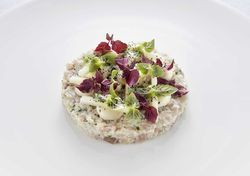
Mackerel Tartare, Oyster, Green Apple & Shiso
Ingredients
- 8 fillets Cornish mackerel skinned and de-boned
- 2 Banana shallots finely diced
- 5 g Chives chopped
- 2 tbsp Crème fraiche
- Lemon zest of one
- 2 Granny smith apples
- 3 tbsp White soy
- 20 sprigs Green shiso
- 20 sprigs Purple shiso
For the oyster cream
- 2 Egg yolks
- 5 Oysters with ‘juice’ reserved
- 1 Lemon juice
- 100 ml Water
- 400 ml Grape seed oil
Instructions
For the Oyster Cream
- Place all ingredients (including the oyster ‘juice’) except the oil into a blender and blend until smooth. Slowly pour in the grape seed oil to emulsify the mix; similar to a mayonnaise.
- Place in a squeezy bottle and set to one side.
For the tartare
- Dice up the mackerel fillets neatly and place over ice to remain chilled.
- Mix the diced mackerel with the shallots, chives, crème fraiche, lemon and white soy until combined.
- Place seasoned mix into a ring in the middle of a plate.
- Dress the top of the tartar with 5 dots of the oyster cream. Then cut the apple into small batons and place on top of the oyster cream. Finish the dish with the shiso cress, placing five of each colour on top of the apple.
- Serve immediately!
Duck confit with braised red cabbage & pear
Duck confit is considered one of the finest French dishes, and for good reason. Most of the cooking and curing time is also inactive, and the recipe is easy to follow – achievable for even the least confident home cooks.
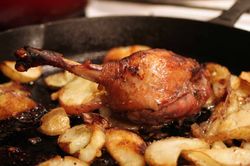
Duck confit
Ingredients
- 6 duck legs
- 1.5 kg duck fat
- 8 tbsp fine salt
- A few sprigs rosemary
- A few sprigs thyme
- 2 bay leaves
- 1 orange zest only
- 1 tbsp black peppercorns
- 6 cloves garlic
- 1 cinnamon stick
For the braised red cabbage and pear
- 1 large red cabbage quartered, cored, and thinly sliced
- 1 large onion finely sliced
- 4 pears quartered, cored, and sliced
- 200 ml red wine
- 1 cinnamon stick
- 1 star anise
- 1 tbsp soft brown sugar
- 1 tbsp red wine vinegar
Instructions
- On the day before serving, combine the salt, rosemary, thyme, bay leaves, orange zest, cinnamon stick, and peppercorns in a large tray or bowl.
- Prick the skin of the duck legs with a fork or skewer and place skin-side down in the salt mixture, and fully submerge. Cover or transfer to a zip-lock bag and refrigerate for at least 12 hours (up to 36 hours).
- Once cured, rinse the curing mixture off of the duck legs and pat dry.
- Preheat the oven to 120C/Gas ½.
- In a casserole or oven-proof saucepan, melt the duck fat and gently add the duck legs to the pan with the garlic cloves. Bring to a simmer and transfer to the oven.
- Cook for 3-4 hours until the meat is tender and the duck is well-coloured. If need be, transfer the duck legs to a baking tray and crisp up the skin in the oven at 200C/Gas 6 for approximately 30 minutes, keeping an eye on the duck, to prevent it from burning.
- For the braised red cabbage and pear
- While the duck is cooking, core and thinly slice the red cabbage and slice the onion. Add to a large saucepan with the wine, cinnamon, star anise, sugar, and vinegar.
- Bring to the boil and cover the pan. Simmer the cabbage for one hour. Add a splash of water if necessary.
- Add the pear to the pan and simmer for another hour. Add water if the cabbage dries out while cooking. Strain (if necessary), season with a generous pinch of salt, and serve alongside the duck confit.
Pork tacos with ‘brown sauce’ salsa
There’s something particularly sociable about building your own tacos at the table. The pork can be left in the oven on low heat and forgotten about while you prepare for your dinner party, and the opinion-dividing ‘brown sauce’ salsa will act as a conversation starter when you’ve run out of small talk topics and forgotten how to socialise. (Trust us, it works perfectly with the pork).
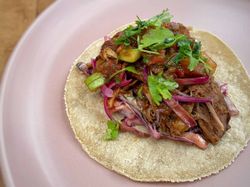
Slow-cooked pork tacos with slaw and pickled red onions
Ingredients
- 12-16 corn tortillas
- 2 kg rindless shoulder of pork cut into 12 pieces
- 1 red onion roughly chopped
For the marinade
- 3 garlic cloves crushed
- 4 tbsp hot sauce I like a mixture of Cholula, Habanero, and Ancho chilli
- 4 tbsp tomato purée
- 3 oranges juiced
- 3 limes juiced
- 4 tbsp white wine vinegar
- 1 tbsp dried oregano
- 1 tbsp ground allspice
- 1 tbsp ground cumin
- 2 tsp ground nutmeg
- 1 tsp ground cloves
For the slaw
- ½ red cabbage thinly sliced
- 1 large carrot grated
- 3 spring onions finely sliced
- Handful fresh coriander to taste
- Mayonnaise to taste, approx. 250ml
- Hot sauce to taste, approx. 50ml
- 1 tbsp white wine vinegar
For the pickled onions
- 2 red onions thinly sliced
- 2 tbsp white wine vinegar
- 2 tbsp caster sugar
Instructions
- Prepare the pork and roughly chop one red onion, then add to a large, non-reactive bowl with all of the marinade ingredients. Mix and place in the fridge to marinade overnight, or for at least 8 hours.
- Heat oven to 160C/Gas 3 and transfer the pork and marinade to a casserole dish. Cover with a lid and place in the oven for 4 hours, until the pork is tender but isn’t too giving. Break up with kitchen tongs and move to a serving bowl.
- While the pork is cooking, make the slaw by adding the red cabbage, grated carrot, sliced spring onions, and chopped coriander to a large mixing bowl. Add a tablespoon of white wine vinegar and mix.
- Mix the mayonnaise with enough hot sauce to produce a liquid with a similar colour to Marie Rose sauce. Mix with the other slaw ingredients and chill in the fridge for at least an hour.
- At this point, make the brown sauce salsa (recipe below).
- To make the pickled onions, put the sliced red onions in a heatproof bowl. Cover with boiled water and leave to stand for 10 minutes. Drain, then stir in the vinegar and caster sugar. Stand for at least 10 minutes before serving.
- Warm the tacos in a frying pan and serve with the pork, slaw, pickled onions, brown sauce salsa, and plenty of napkins.
Grilled cauliflower with caper raisin dressing & cashew nut butter
Chef Jon Atashroo’s grilled cauliflower dish is best finished on the barbecue, but given the often bleak UK weather conditions, a hot griddle pan will do. A vegetarian dinner party dish that’ll appeal to even the most stubborn of meat-eaters.
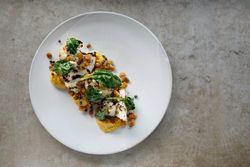
Grilled Cauliflower with Caper Raisin Dressing & Cashew Nut Butter
Ingredients
- 1 large Cauliflower
- 170 g Cashew nut butter
- 10 g Fresh turmeric
- 10 g Maple syrup
- 100 g Golden raisins
- 100 g Lilliput capers
- 100 g Baby spinach optional
- 1 Shallot
- Olive oil
Instructions
- Preheat the oven to 140C. Trim all the green leaves from the cauliflower, allowing 1 small or ½ large cauliflower per person. Drizzle with olive oil, a generous dusting of fine salt and bake in the oven. Start with 20 minutes, checking the root with a knife to see when it’s tender. The florets should yield and just hold together. Bake for another 5-10 minutes if needed.
- Whilst the cauliflower is cooking, make the cashew butter. We make our own in the restaurant but it requires a very good blender and a lot of patience. Use a quality brand like Meridian cashew butter, add 10g maple syrup and 10g fresh, finely grated turmeric. Smash the turmeric in a pestle and mortar if available, or grate finely on a micro plane. You can use dried if fresh is not available but the fresh gives such an ethereal perfumed finish to the dish it is well worth seeking out. Mix very well.
- (N.B The recipe makes more than you need but it keeps well in the fridge & is delicious with pretty much anything.)
- Caper and raisin dressing gives a sweet, sour and salty finish that lifts the cauliflower and balances the richness of the butter. Take 100g golden raisins, cover with water in a pan and bring to the boil. When boiled, immediately turn off and drain the raisins, leave in the sieve to drain dry. Mix with 100g capers (adding a good dash of their vinegary brine). Finally add a finely chopped shallot and a drizzle of olive oil. Mix together.
- Preheat a griddle pan or – better – use a bbq. Break the cauliflower into natural chunky florets and char the cauliflower to get some colour and a bit of smoke until it’s hot inside.
- Meanwhile, in another pan, warm up some of the caper and raisin mix with a tablespoon of water. When hot, throw in the cauliflower florets and gently turn to coat in the mix. Drizzle with a little olive oil.
- To serve, dot some of the cashew butter on each serving plate. Place the cauliflower florets on next and then top with some of the caper and raisin that is left behind in the pan.
- We serve with some wilted spinach as a garnish but this is totally up to you. Fresh coriander leaves would also work well.
Bouillabaisse
A traditional Provençal dish originating from the port city of Marseille, Bouillabaisse is a stew originally made by Marseille fishermen, using unpopular bony rockfish. Featuring a school of several fish, chef Alex Jackson’s Bouillabaisse recipe is relatively simple to follow at home. An ideal fish-based dinner party main.
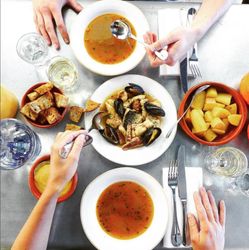
Bouillabaisse
Ingredients
- 1 Small Crab this will be smashed up so try to buy cheap, crippled crabs if possible
- 500 g Red mullet filleted, head and bones reserved, gills removed and washed
- 500 g Gurnard filleted, head and bones reserved, gills removed and washed
- 400 g John Dory filleted
- 400 g Bream filleted
- 400 g Monkfish Tail Fillet
- 400 g Hake Fillet
- 1 kg Mussels cleaned
- 1 Small Octopus washed
To marinate the fish
- 1 small pinch saffron
- ½ clove garlic crushed
- 1 tbsp Chopped parsley
- 1 tbsp Olive oil
For the broth
- 4 tbsp Olive oil
- 2 Onions roughly chopped
- 1/2 head celery roughly chopped
- 1 head garlic smashed up a bit
- 1 bulb Florence fennel roughly chopped
- 1 handful Wild Fennel Stalks if available, roughly chopped
- 4 Bay leaves
- 4 Sprigs thyme
- 1 tsp Black peppercorns
- 1 tbsp Fennel seeds
- The peel from ½ orange, ideally dried, but fresh is fine
- 1 dried Spanish chilli, stalk and seeds removed
- 1 tsp Good quality saffron
- 1 kg Ripe tomatoes roughly chopped
- 1/2 bottle dry white wine
- Big glug of brandy
- Big glug of pastis
- Cold Water
For the potatoes and croutons
- 1 kg Waxy red potatoes (such as Desiree) peeled, cut into chunks
- ½ of a day-old crusty baguette sliced thinly
For the Rouille
- 1 fat or 2 small cloves of garlic, peeled, green sprout removed
- 2 Egg yolks
- 4 Salted anchovy fillets
- 2 tbsp Fresh bread crust removed
- A small pinch of saffron
- ½ tsp Powdered cayenne
- 100 ml Olive oil
- 1 tbsp Lemon juice
- 1 tsp Red wine vinegar
Instructions
To make the broth
- Heat the oil in a big pot and add the onion, celery, garlic, fennel, fennel stalks (if using), bay and thyme. Season with a big pinch of salt. Fry the vegetables on a medium heat, stirring often, for 10 minutes, or until beginning to soften. Add all the other ingredients apart from the saffron and tomatoes, lower the heat to medium/low and continue to cook for another 20 minutes, or until everything is quite soft, has taken on only a little colour and is smelling excellent. Add the saffron, stir well, and cook over a low heat for another 5 minutes.
- Kill the crab, if not dead already, by spiking the hole under the flap on the underneath of its body. Smash up the crab with a pestle or a heavy rolling pin. Add the smashed crab, shell, juices and all, to the pot. Fry the crab with the vegetables over a medium heat for about 5 minutes, stirring often, until the rich crab shell flavour starts to make itself known. Add the tomatoes to the pot and stir well to mix. Cook for a few minutes while you gather the fish bones.
- Add the cleaned, gilled fish heads and bones to the pot. Smash them up with your implement until you have a delicious mulch of bones, tomatoes, saffron and oil. To this mulch add the white wine, brandy and pastis, then water to top it up – enough water so there’s enough broth, but remember the more water you add here, the less powerful the broth will be, so get it right!
- Bring the Bouillabaisse to the boil, then turn down to a fast simmer and cook for about 45 minutes. Skim the broth to remove any impurities. Add half the mussels to the pot. They will boil and overcook, but will give up their tasty juices and enrich the broth nicely. Taste the broth. It should taste full, rounded and something approaching delicious. If not, continue to cook and reduce slightly until you are happy that a good flavour is under the surface.
- Strain the broth. Squish the mulch with something sturdy to encourage it to release all the broth. Rinse out the pot if there are any nasty bits left inside, and return the strained broth to the pot. Put the cleaned octopus in the broth and bring slowly to the boil, then simmer the octopus for around half an hour, or until cooked but not mushy. Remove the octopus, cut into appropriate pieces and reserve. Taste the broth carefully for seasoning – by now it should be utterly delicious. Set the broth aside – this can happily be made a day ahead.
To marinate the fish
- Cut the (filleted) fish into bite size pieces, there should be one nice piece of each fish per person. Put it in a bowl and add the saffron, crushed garlic, chopped parsley and olive oil. Stir well to mix.
To make the Rouille
- Completely soak the bread in a little of the hot bouillabaisse broth, then allow to cool.
- Crush the garlic, with a little salt, to a fine white paste in the pestle and mortar. Add the anchovy fillets, saffron and broth-soaked bread, and pound to a thick paste. Add the egg yolks and cayenne pepper, and emulsify as best you can. Start to add the olive oil very slowly – at first drop by drop, then in a slow stream. As the emulsion starts to thicken, add a few drops of lemon juice or vinegar, and a few of water, then continue with the oil. It’s important to add the lemon, vinegar and water gradually as this will help it not to split. When all the oil is used up, taste the sauce for salt and acid, trying to find a nice balance.
- A Rouille, stabilised with bread and anchovy, is harder to split than an Aïoli, but I have managed it.
For the potatoes
- Pour some of the broth off into a smaller pot and boil the potatoes in this. For those worried about not having enough broth, a little half broth/half water arrangement is fine. Try not to overcook.
For the croutons
- Lay the thinly sliced baguette on a tray and drizzle lightly with olive oil. Bake at 150C for 10 minutes or until golden brown and crunchy.
To cook the fish and serve
- Season the marinated fish with salt. Poach the fish in the broth at a gentle simmer for around 5 minutes, turning once if necessary. Add the mussels and (cooked, chopped) octopus towards the end – they need about a minute or two to cook and heat through.
- If you are worried about smashing the fish or not having enough space, poach the fish in batches according to size of morsel, species and firmness: monkfish or gurnard, for example, will hold their shape more easily than others, and could be done first and kept warm.
- Remove the fish from the broth and keep warm. Bring the broth briefly to a fast, rolling boil, then pour into bowls, piping hot. Serve the broth first, with bowls of Rouille and croutons to float on top.
- As your guest coo over the broth, bring over a platter of cooked fish and shellfish, arranged artfully by species on a huge platter. The cooked fish should be moistened with broth to keep it warm and juicy. Bring also the warm potatoes to complete the picture. There should be much hot broth in reserve for top-ups.
Pecan banoffee pie
A take on the English classic, this banoffee pie recipe has a buttery biscuit base spiked with toasted pecans (which can optionally be removed). It’s also decorated with optional pecans as well as a small pinch of grated chocolate for an extra touch of decadence.

Pecan Banoffee Pie
Tarte Tatin
Named for the Tatin sisters said to have created the dish, the Galvin Brothers’ Tarte Tatin is a perfect dinner party dessert, using Braeburn apples and puff pastry, served with Calvados-laced crème Normande.
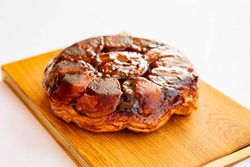
Tarte Tatin
Equipment
- 20cm ovenproof, deep-sided pan
Ingredients
- 7 Braeburn apples peeled, halved and cored
- 120 g puff pastry
- 110 g salted butter softened
- 130 g caster sugar
For the Crème Normande
- 120 ml crème fraîche
- 40 g icing sugar
- 1 ½ tbsp Calvados
Instructions
- Begin by preparing the base of your tart. On a lightly floured surface, roll out the puff pastry to a 21cm round. Using a fork, prick the pastry all over then leave in the fridge to rest for 40 minutes.
- Preheat the oven to 160°C/gas mark 3.
- In a 20cm ovenproof frying pan – or tarte Tatin mould, if you have one – spread the softened butter in an even layer, followed by the caster sugar. Arrange the apple pieces over the sugar, standing on their sides, with two halves lying flat in the centre of the dish.
- Remove the pastry round from the fridge and lay it carefully over the arranged apple halves, tucking any overhanging pastry edges down the sides of the pan. Place the pan on the hob and caramelise the sugar over a medium heat for approximately 10 minutes, before transferring to the preheated oven. Bake for 90 minutes.
- Meanwhile, make the crème Normande. Combine the crème fraîche, icing sugar and Calvados together in a bowl and mix well. Cover with cling film and refrigerate for 1 hour before serving.
- Remove the tarte Tatin from the oven and leave to cool for at least 30 minutes, before turning out onto a chopping board. Cut into 4 portions and serve with a generous spoonful of the crème Normande.
Strawberry millefeuille
A restaurant quality dessert from one of London’s oldest Michelin-starred restaurants, Pied à Terre, this strawberry millefeuille recipe is also suited to any seasonal fruit.
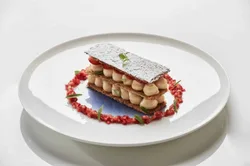
Strawberry Millefeuille
Equipment
- Piping bag
Ingredients
- 4 strawberries sliced
- 4 strawberries finely chopped
- Small lemon verbena leaves for garnishing
- 1 packet puff pastry
- Icing sugar
For the crème patisserie
- 250 ml milk
- 3 egg yolks
- 45 g sugar
- 30 g corn flour
- ½ vanilla pod seeds scraped
- 25 g cold butter diced
Instructions
- Preheat your oven to 180C/Gas 4.
- Start with the pastry. Take half of it and roll it out to a thickness of 2mm, using icing sugar instead of flour, and place on a baking tray lined with greaseproof paper. Place another layer of paper on top of the pastry and then something heavy like another baking tray. This will prevent it puffing up too much. Bake for 15-20 minutes until it’s golden brown.
- Remove from the oven and immediately cut 3 rectangles, 6cm wide by 12cm long. It must be hot when you cut the pastry, otherwise it will break and crumble.
- Now make the crème patisserie. Add the milk and vanilla seeds into a pan and bring to the boil, then keep aside.
- Whisk the eggs and sugar vigorously until pale and fluffy, and then add the corn flour and fold in with a spatula. Slowly pour in hot milk whilst whisking and then put the mix back in the pan and cook on a very low heat till the mix is very thick, stirring every so often.
- Remove from the heat and mix into the cold butter. Allow to cool on the side before putting the fridge, covered with clingfilm, for an hour to set.
- When set, whip it for a minute and transfer to a piping bag.
- To serve, place one piece of puff pastry on your serving plate and pipe 2 lines of crème patisserie along it before placing a layer of strawberry slices. Repeat the process in reverse.
- For the ultimate presentation, place your chopped strawberries in a perfect circle around the dessert. Garnish the dish with a few tiny lemon verbena leaves.

